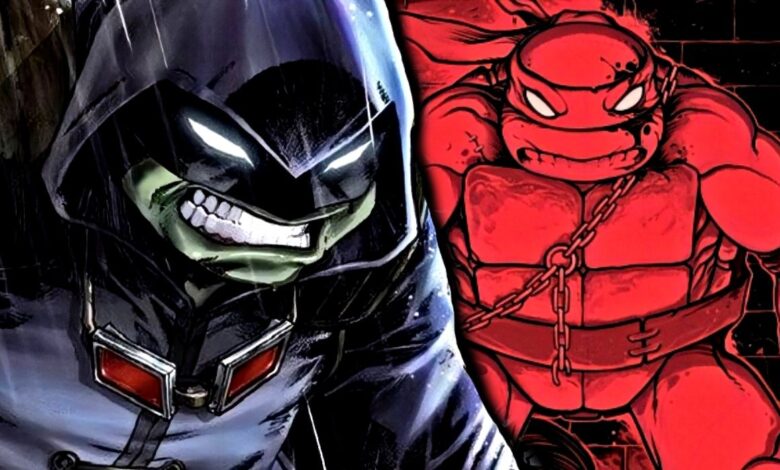Last Ronin Writer Confirms Future Plans to Expand The Roninverse Even Further

Summary
- Tom Waltz and Kevin Eastman’s Teenage Mutant Ninja Turtles: The Last Ronin has opened up a rich narrative world that still has untold stories to reveal, something that Waltz suggested he’s well-aware of in an interview with Screen Rant.
- Waltz hints at more Roninverse tales to come, suggesting that there are more stories to come “beyond” the current sequel to the groundbreaking Teenage Mutant Ninja Turtles alternate continuity miniseries.
- The Roninverse has the potential to expand in many different ways: sequels, prequels, side stories, and deeper dives into the psychological journies of its growing cast of characters.
Legendary Teenage Mutant Ninja Turtles writer Tom Waltz spoke to Screen Rant about the future of the “Roninverse,” suggesting that there are more stories to tell in the franchise’s gamechanging alternate continuity. Beyond just their critical and commercial success, The Last Ronin and its follow-ups have established a flourishing narrative world that still has stories left in it to be told.
In an exclusive interview with Screen Rant, Waltz discussed his tenure with Teenage Mutant Ninja Turtles, in which he has become a third pillar of the franchise’s success, alongside his Last Ronin co-author Kevin Eastman, and series co-creator Peter Laird.
Waltz’ hint about future Roninverse stories may seem oblique at first, but upon closer examination, it is evident that the creative gears continue to turn, and that the series’ creators still have things they want to achieve within the continuity.
Teenage Mutant Ninja Turtles: The Last Ronin comprised five issues, released between late 2020 and the spring of 2022. The five issue Lost Years prequel/sequel followed in 2023. The Last Ronin II – Re-Evolution has just begun its run, with the first issue out now.
Related
TMNT Writer Explains Why The Last Ronin Had To Be Michelangelo
Teenage Mutant Ninja Turtles: The Last Ronin writer Tom Waltz reveals there was no better choice than Michelangelo as the series’ Ronin.
Tom Waltz Drops Major Hint At Plans For The Roninverse “Beyond” Re-Evolution
Teenage Mutant Ninja Turtles: The Last Ronin – Written By Kevin Eastman & Tom Waltz; Art By Eastman, Esau and Isaac Escorza, & Ben Bishop
Speaking with Screen Rant, Tom Waltz graciously went into great detail about various aspects of his work on the Ninja Turtles franchise, from his most exciting creative decisions to some of his hopes for the future. Waltz didn’t speak directly about plans for more Roninverse titles; rather, he indicated that they are coming incidentally, by way of answering a question about the distinctions between writing contemporary Ninja Turtles, and what went into shaping the original 1980s stories. According to Waltz, he and co-author Kevin Eastman’s Ninja Turtles stories are confronting the same themes that have driven the series since its inception.
It’s worth taking a closer look at the following exchange from Waltz’ conversation with Screen Rant, because it holds insight into how Teenage Mutant Ninja Turtles stories are developed, as well as a suggestion that more Roninverse stories are inevitable. Screen Rant asked:
SR: Similarly, how does the perspective of 2024 shape these characters, given that the original Mirage Studios comics were so steeped in where comics found themselves in the mid-80s?
TOM: “Again, sadly, not much has changed if you really think about it. Adults make the terrible problems, forcing the youth of the world to confront them and, hopefully, resolve them. Just turn on the news these days and you’ll see the same thing everywhere — ancient wars being fought by modern young men and women…and to what end? It’s a tragic theme Kevin and I fully intend to tackle as best we can in this second volume (and beyond).”
By “second volume,” Waltz is referencing the currently ongoing sequel miniseries, Re-Evolution, which is shaping up to be a vital expansion of the continuity. His addendum of “and beyond” to the sentence seemingly points toward more Roninverse stories beyond that.
Waltz reference to a “second volume” shouldn’t be confused with the upcoming relaunch of IDW’s TMNT ongoing, following the conclusion of the title’s decade-plus-long run with the landmark Teenage Mutant Ninja Turtles #150. The ongoing and The Last Ronin exist as separate continuities, telling distinct stories.
This can be confidently inferred for several reasons. Readers have to look no further than Tom Waltz’ quote to find the first, most crucial of these: Waltz and Kevin Eastman still feel a sense of creative urgency with Teenage Mutant Ninja Turtles, and the Roninverse has been a key part of keeping them invigorated as storytellers, and keeping fans of the franchise engaged, over the past decade. The Roninverse has played a central role in an overall renaissance for the franchise, something that its creators seem to want to keep the momentum going on.
The Roninverse Has Already Grown Far Beyond Its Original Scope
TMNT: The Last Ronin II Re-Evolution – Written By Kevin Eastman & Tom Waltz; Art By Eastman, Esau and Isaac Escorza, & Ben Bishop
The formation of a new family around Michelangelo is the clearest signal that the Roniverse continuity could sustain its own ongoing series.
The novel premise of TMNT: The Last Ronin casts Michelangelo as the sole surviving brother in a dark, alternate future. Though the story centered around a quest for vengeance, it proved to be much more than just a “dark, gritty” alternative to the more familiar tone of the series. In fact, Last Ronin allowed for many of the themes inherent in the franchise to be elaborated in a unique way, while also delivering all-time great Ninja Turtles action and adventure.
The positive fan response to the series – and their appetite for more stories set in the world of The Last Ronin – gratified the series’ bold swing, and ensured the story wouldn’t end there. The Last Ronin: The Lost Years followed, serving as both a prequel and a sequel to the original miniseries, in the process greatly widening the scope of the Roninverse, as it built on the aftermath of the original’s satisfying conclusion. Further, it proved that the appeal of the alternate continuity extended beyond its initial premise.
Now, another sequel series – The Last Ronin II: Re-Evolution – is currently in progress, and though where it will leave its expanding cast of new characters won’t be known for some time, the future of the Roninverse “beyond” even that can still be speculated about. The formation of a new family around Michelangelo is the clearest signal that the Roniverse continuity could sustain its own ongoing series, or at least, that there are multiple miniseries’ worth of stories to tell with this exciting batch of characters.
The Roninverse Can Continue To Expand Along More Than One Axis
TMNT: The Last Ronin – The Lost Years – Written By Kevin Eastman & Tom Waltz; Art By Eastman, Ben Bishop, & S.I. Gallant
As much as the franchise’s creators can continue to widen the Roninverse outward, they can also deepen their exploration of characters’ emotional and mental states, leading to even more resonant, effective narratives.
The success of The Last Ronin has led to the promise of more than one adaptation of the already-iconic storyline. A video game take on the story is said to be in active development, while an R-rated live-action film version was just announced. In addition to the creative impulse to continue working within the thrilling confines of the Roninverse, the authors of Teenage Mutant Ninja Turtles have the added incentive of actively keeping it in audiences’ minds. Given the great amount of potential the continuity has to offer, more Roninverse-set stories offer the perfect merger of practical and artistic consideration.
As The Last Ronin – The Lost Years already proved, Tom Waltz and Kevin Eastman have the opportunity to expand in Roninverse in more than one narrative direction. While Re-Evolution takes the next step forward in the timeline, more prequels could continue to fill in the backstory of the continuity. From further exploration Michelangelo’s era as a lone-wolf, waiting to avenge his family, to solo adventures for the latest generation of Turtles, the Roninverse can go wherever Waltz, Eastman, and co-creator Peter Laird recognize the chance to tell an impactful tale.
As much as the franchise’s creators can continue to widen the Roninverse outward, they can also deepen their exploration of characters’ emotional and mental states, leading to even more resonant, effective narratives. The world of the Roninverse is still dark, and full of dangers, and now that Michelangelo has a new family, much of the tension for the character will come from his fear of losing them once more. His new siblings each have their own emotional dynamics to explore further – in other words, there are profligate chances to expand Teenage Mutant Ninja Turtles’ Roninverse, something writer Tom Waltz certainly knows best.
Teenage Mutant Ninja Turtles
Teenage Mutant Ninja Turtles (TMNT) is a multi-media franchise that began with Kevin Eastman and Peter Laird’s comics in the 1980s. Throughout the years, their comic books expanded to movies, TV shows, video games, and toys. Most notably, the animated Teenage Mutant Ninja Turtles ran for nearly a decade and has become a nostalgic staple of the ‘80s and ‘90s. Several other movies have featured the four anthropomorphic turtle brothers (Leonardo, Michelangelo, Donatello, and Raphael), including the trilogy of live-action films in the ‘90s and the more recent movies Teenage Mutant Ninja Turtles and its sequel Teenage Mutant Ninja Turtles: Out of the Shadows.
Source link



